1995 CADILLAC SEVILLE change wheel
[x] Cancel search: change wheelPage 200 of 410
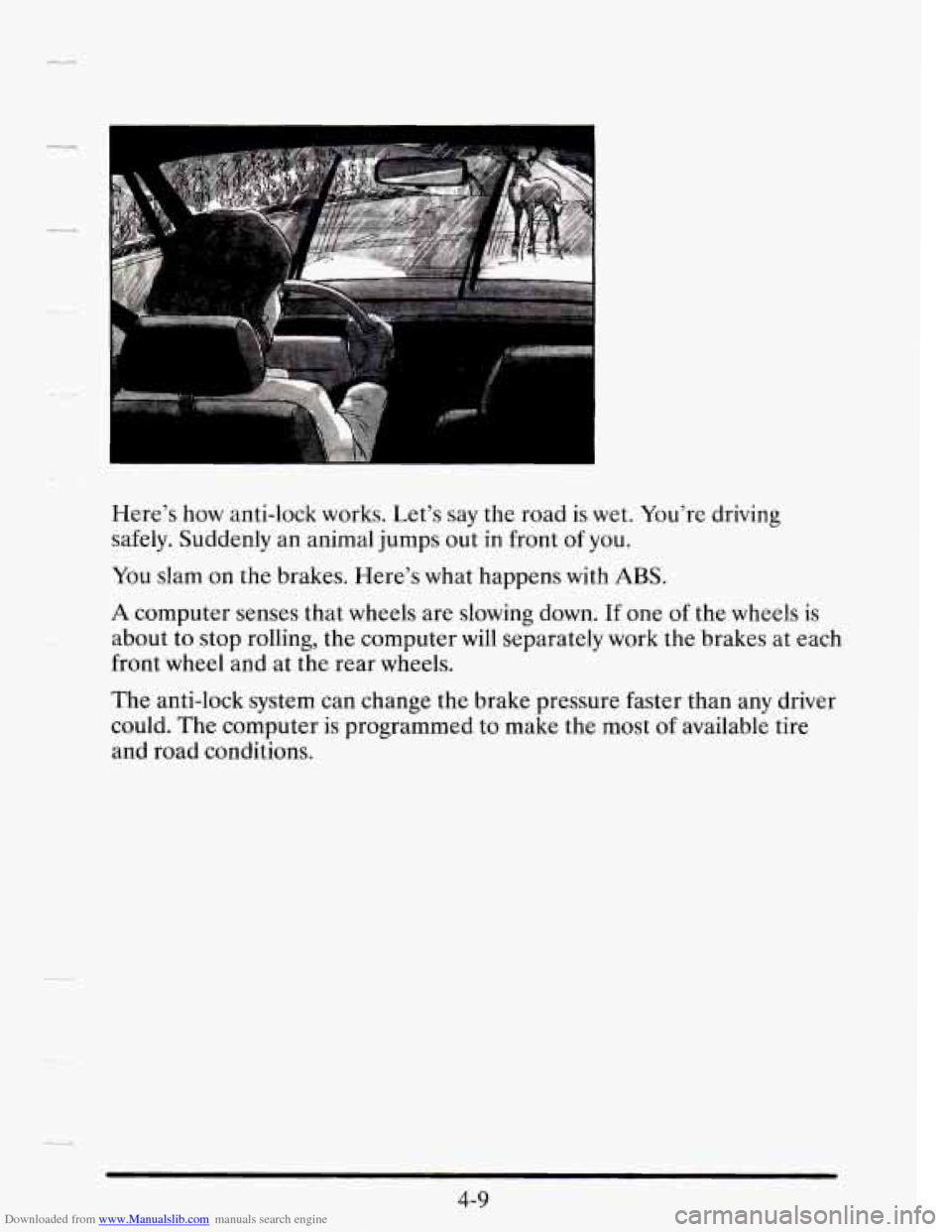
Downloaded from www.Manualslib.com manuals search engine Here’s how anti-lock works. Let’s say the road is wet. You’re driving
safely. Suddenly an animal jumps out
in front of you.
You slam on the brakes. Here’s what happens with
ABS.
A computer senses that wheels are slowing down. If one of the wheels is
about to stop rolling, the computer
will separately work the brakes at each
front wheel and at the rear wheels.
The anti-lock system can change the brake pressure faster than any driver
could.
The computer is programmed to make the most of available tire
and road conditions.
Page 201 of 410
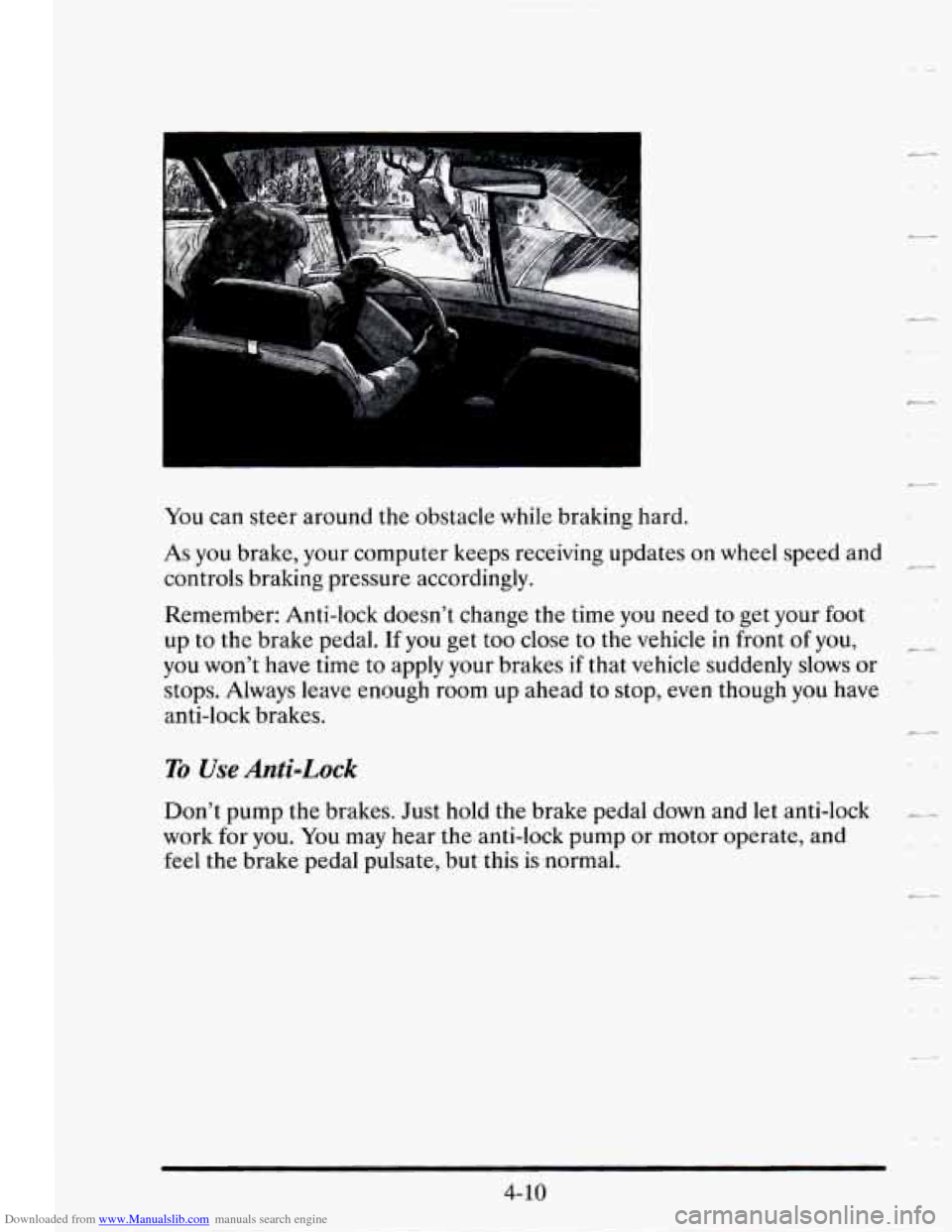
Downloaded from www.Manualslib.com manuals search engine You can steer around the obstacle while braking hard.
As you brake, your computer keeps receiving updates on wheel speed and
controls braking pressure accordingly. rc-
Remember: Anti-lock doesn’t change the time you need to get your foot
up to the brake pedal.
If you get too close to the vehicle in front of you,
you won’t have time to apply your brakes if that vehicle suddenly slows or
stops. Always leave enough room up ahead to stop, even though you have
anti-lock brakes.
To Use Anti-Lock
Don’t pump the brakes. Just hold the brake pedal down and let anti-lock
work
for you. You may hear the anti-lock pump or motor operate, and
feel the brake pedal pulsate, but this is normal.
4-10
c.4
.
c-
c-
Page 203 of 410
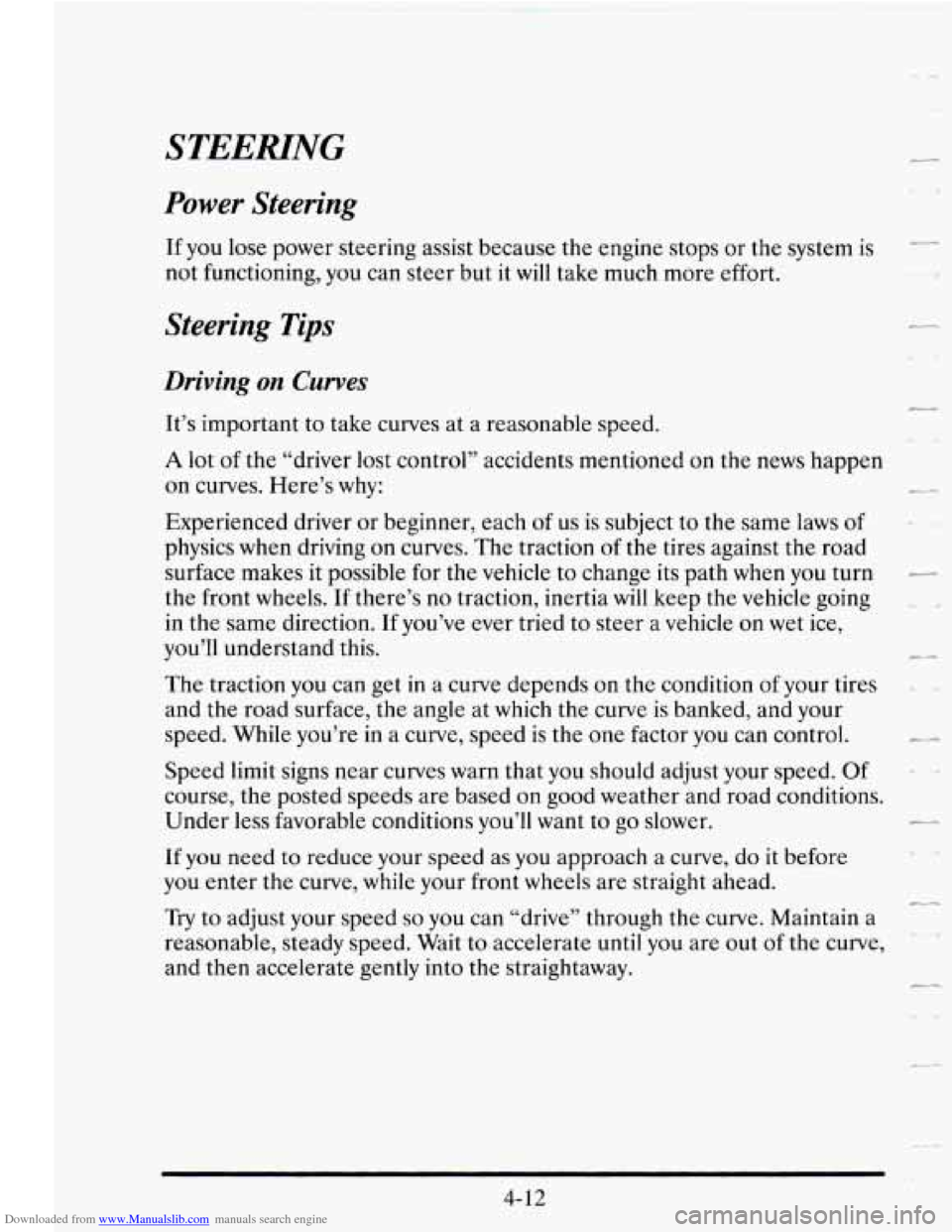
Downloaded from www.Manualslib.com manuals search engine STEERING
Power Steering
If you lose power steering assist because the engine stops or the system is
not functioning, you can steer but it
will take much more effort.
Steering Tips
Driving on Curves
It’s important to take curves at a reasonable speed.
A lot of the “driver lost control” accidents mentioned on the news happen
on curves. Here’s
why:
Experienced driver or beginner, each of us is subject to the same laws of
physics when driving on curves. The traction of the tires against the road
surface makes it possible for the vehicle to change its path when you turn
the front wheels.
If there’s no traction, inertia will keep the vehicle going
in the same direction. If you’ve ever tried to steer a vehicle
on wet ice,
you’ll understand this.
The traction you can get in a curve depends on the condition
of your tires
and the road surface, the angle at which the curve is banked, and your
speed. While you’re
in a curve, speed is the one factor you can control.
Speed limit signs near curves warn that you should adjust your speed.
Of
course, the posted speeds are based on good weather and road conditions.
Under less favorable conditions you’ll want to go slower.
If you need to reduce your speed as you approach a curve, do it before
you enter the curve, while your front wheels are straight ahead.
Try to adjust your speed so you can “drive’’ through the curve. Maintain a
reasonable, steady speed. Wait to accelerate until you are out
of the curve,
and then accelerate gently into the straightaway.
4-12
Page 249 of 410

Downloaded from www.Manualslib.com manuals search engine TOWING YOUR VEHICLE
Try to have a GM dealer or a professional towing service tow your
Cadillac. The usual towing equipment is:
A.
B.
C. Sling Type
Wheel Lift
Car Carrier
If your
adding
wheels, vehicle
has been changed or modified since it was factory-new by
aftermarket items like fog lamps, aero skirting or special tires and
these instructions and illustrations may not be correct.
Before you
do anything, turn on the hazard warning flashers.
When you call, tell the towing service:
0 That your vehicle cannot be towed from the front or rear with
sling-type equipment.
0 That your vehicle has front-wheel drive.
The make, model and year of your vehicle.
Whether you can still move the shift lever.
If there was an accident, what was damaged.
5-10
Page 260 of 410
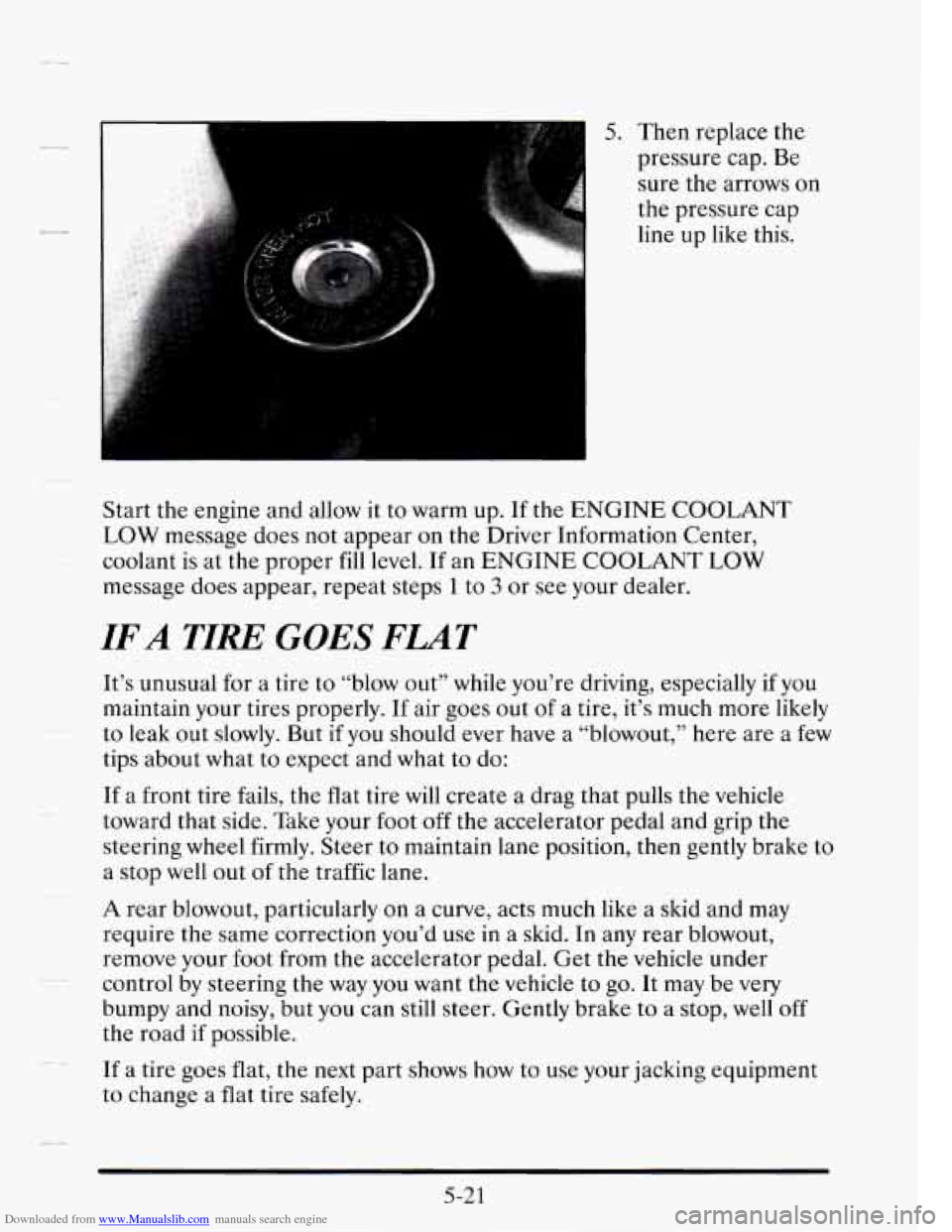
Downloaded from www.Manualslib.com manuals search engine 5. Then replace the
pressure
cap. Be
sure the arrows on
the pressure cap
line up
like this.
Start the engine and allow
it to warm up. If the ENGINE COOLANT
LOW message does not appear on the Driver Information Center,
coolant
is at the proper fill level. If an ENGINE COOLANT LOW
message does appear, repeat steps 1 to 3 or see your dealer.
IFA TIRE GOES FLAT
It’s unusual for a tire to “blow out” while you’re driving, especially if you
maintain your tires properly.
If air goes out of a tire, it’s much more likely
to leak out slowly. But if you should ever have a “blowout,” here are a few
tips about
what to expect and what to do:
If a front tire fails, the flat tire
will create a drag that pulls the vehicle
toward that side. Take your foot off the accelerator pedal and grip the
steering wheel firmly. Steer to maintain lane position, then gently brake to
a stop well out of the traffic lane.
A rear blowout, particularly on a curve, acts much like a skid and may
require the same correction you’d use in a skid. In any rear blowout,
remove your foot from the accelerator pedal. Get the vehicle under
control by steering the way you want the vehicle
to go. It may be very
bumpy and noisy, but you can still steer. Gently brake to a stop, well off
the road
if possible.
If
a tire goes flat, the next part shows how to use your jacking equipment
to change a flat tire safely.
5-2 1
Page 261 of 410
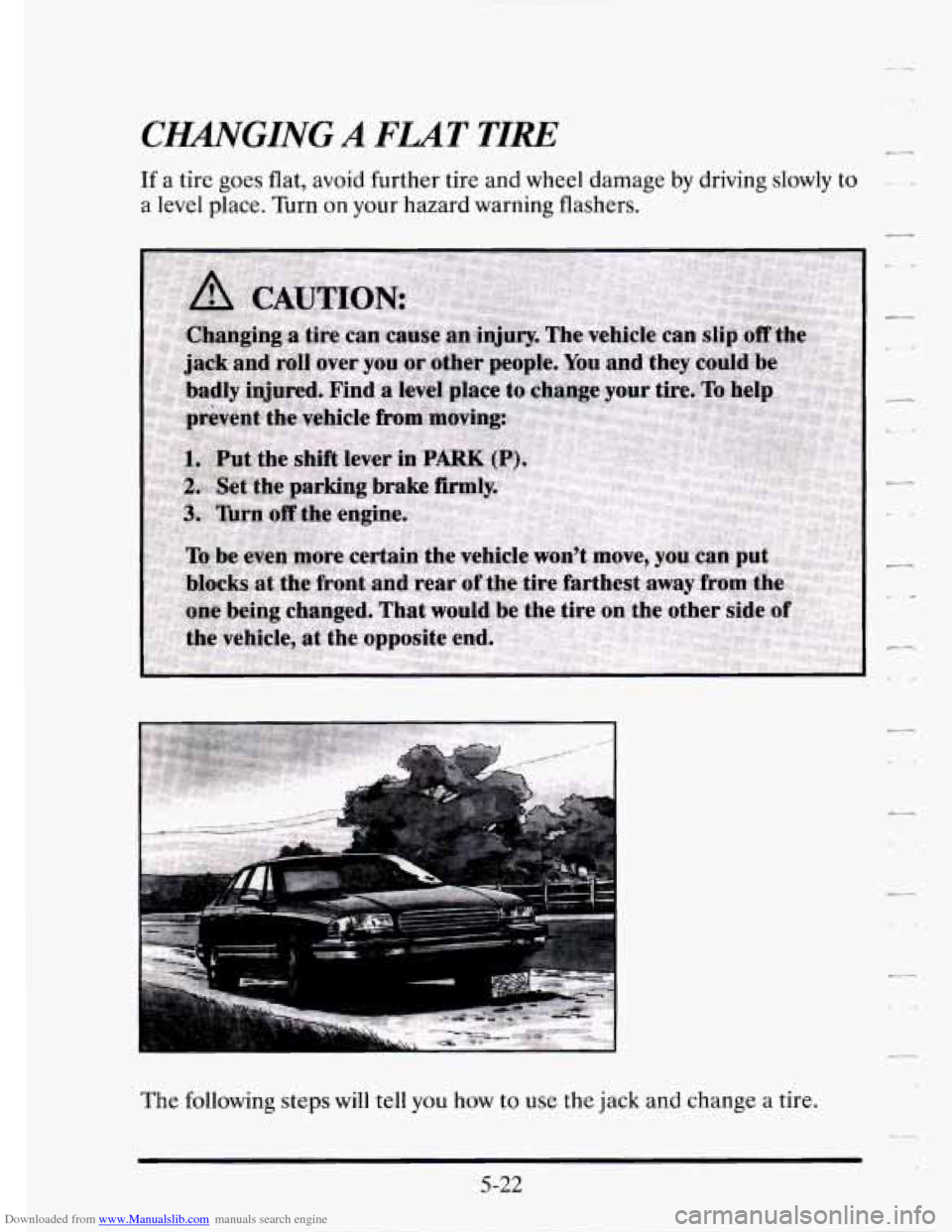
Downloaded from www.Manualslib.com manuals search engine C.GING A FLAT TIRE
If a tire goes flat, avoid further tire and wheel damage by driving slowly to
a level place. Turn on your hazard warning flashers.
The following steps will tell you how
to use the jack and change a tire.
5-22
Page 395 of 410
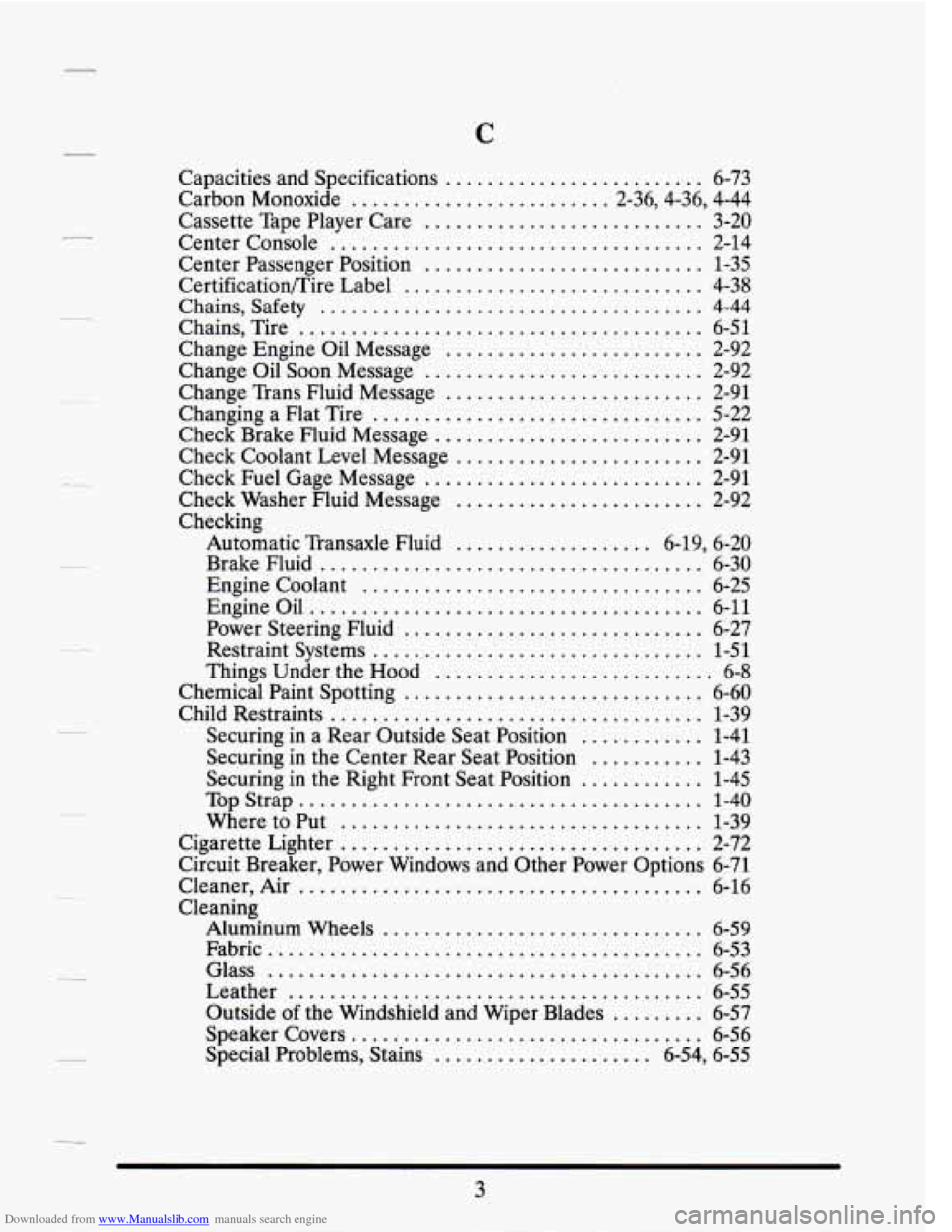
Downloaded from www.Manualslib.com manuals search engine C .
.
.
.
I-
.
.-
..
.
.
Capacities and Specifications ......................... 6-73
Carbon Monoxide ......................... 2.36.4.36, 4.44
Cassette Tape Player Care ........................... 3-20
Center Console .................................... 2-14
Center Passenger Position ........................... 1-35
Certificationnire Label ............................. 4-38
Chains. Safety ..................................... 4-44
Chains. Tire ....................................... 6-51
Change Engine Oil Message ......................... 2-92
Change Oil Soon Message ........................... 2-92
Change Trans Fluid Message ......................... 2-91
Changing a Flat Tire ................................ 5-22
Check Brake Fluid Message .......................... 2-91
Check Coolant Level Message ........................ 2-91
Check Fuel Gage Message ........................... 2-91
Check Washer Fluid Message ........................ 2-92
Checking
Automatic Transaxle Fluid
................... 6.19. 6-20
Brake Fluid ..................................... 6-30
Engine Coolant ................................. 6-25
Engine Oil ...................................... 6-11
Power Steering Fluid ............................. 6-27
Restraint Systems ................................ 1-51
Things Under the Hood ........................... 6-8
Chemical Paint Spotting ............................. 6-60
Child Restraints .................................... 1-39
Securing in a Rear Outside Seat Position ............ 1-41
Securing in the Center Rear Seat Position ........... 1-43
Securing in the Right Front Seat Position ............ 1-45
Top Strap ....................................... 1-40
Where to Put ................................... 1-39
Cigarette Lighter ................................... 2-72
Circuit Breaker. Power Windows and Other Power Options 6-71
Cleaner. Air ....................................... 6-16
Cleaning
Aluminum Wheels
............................... 6-59
Fabric .......................................... 6-53
Glass .......................................... 6-56
Leather ........................................ 6-55
Outside of the Windshield and Wiper Blades ......... 6-57
Speaker Covers .................................. 6-56
Special Problems. Stains ..................... 6-54. 6-55
3
Page 407 of 410
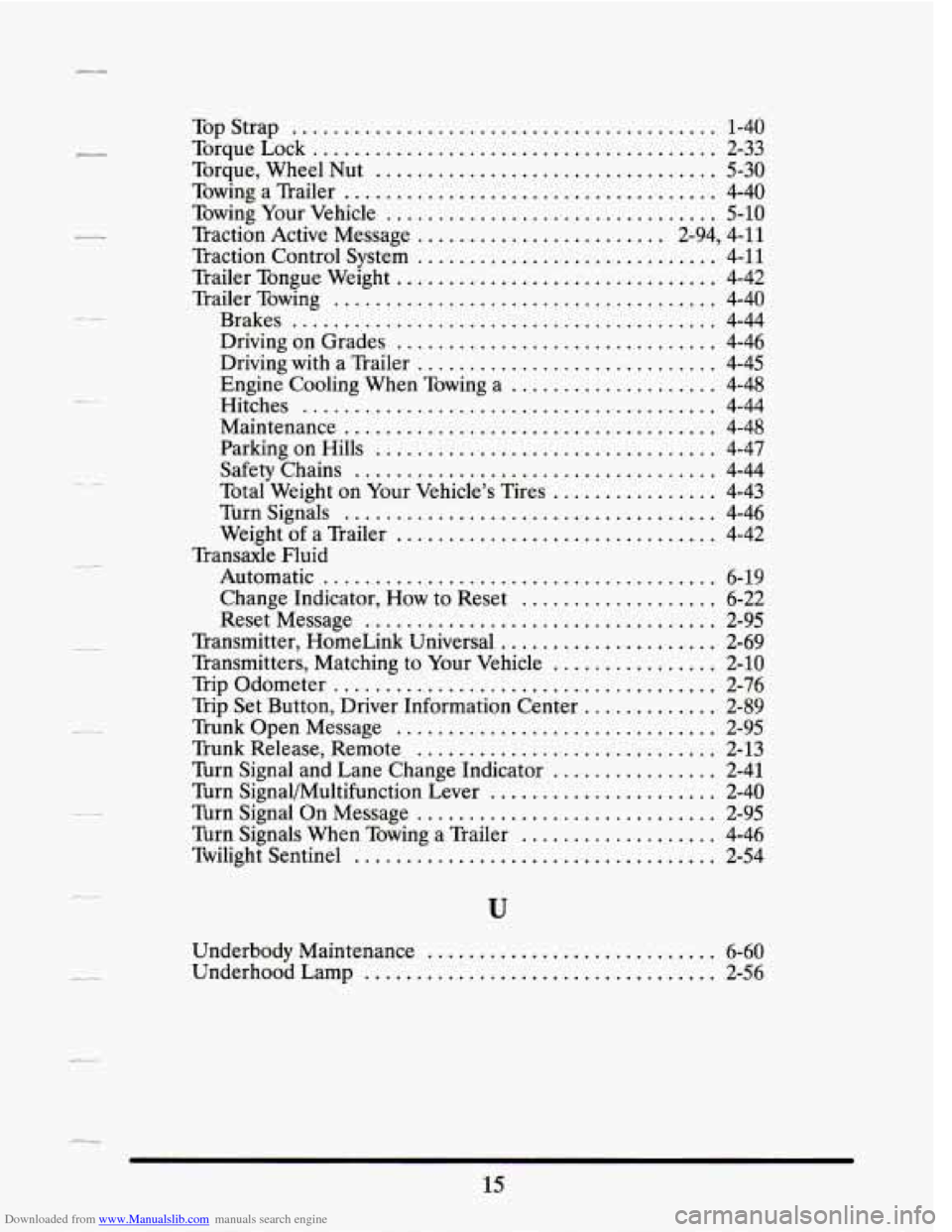
Downloaded from www.Manualslib.com manuals search engine .
.
r
.
.
..
.
TopStrap ......................................... 1-40
Torque Lock
....................................... 2-33
Torque. Wheel Nut
................................. 5-30
Towing a Trailer
.................................... 4-40
Towing Your Vehicle
................................ 5-10
Traction Active Message
........................ 2.94. 4.11
Traction Control System
............................. 4-11
Trailer Tongue Weight
............................... 4-42
Trailer Towing
..................................... 4-40
Brakes ......................................... 4-44
Driving on Grades
............................... 4-46
Driving with a Trailer
............................. 4-45
Engine Cooling When Towing a
.................... 4-48
Hitches
........................................ 4-44
Maintenance
.................................... 4-48
Parking on Hills
................................. 4-47
Safety Chains
................................... 4-44
Turn Signals
.................................... 4-46
Weight of a Trailer
............................... 4-42
Automatic
...................................... 6-19
Reset Message
.................................. 2-95
Transmitter, HomeLink Universal
..................... 2-69
Transmitters. Matching to Your Vehicle
................ 2-10
Trip Odometer
..................................... 2-76
Trunk Open Message
............................... 2-95
Trunk Release. Remote
............................. 2-13
Turn Signal/Multifunction Lever
...................... 2-40
Turn Signal On Message
............................. 2-95
Turn Signals When Towing a Trailer
................... 4-46
Twilight Sentinel
................................... 2-54
Total Weight
on Your Vehicle’s Tires
................ 4-43
Transaxle Fluid Change Indicator. How to Reset
................... 6-22
Trip Set Button. Driver Information Center
............. 2-89
Turn Signal and Lane Change Indicator
................ 2-41
U
Underbody Maintenance ............................ 6-60
Underhood Lamp
.................................. 2-56
15